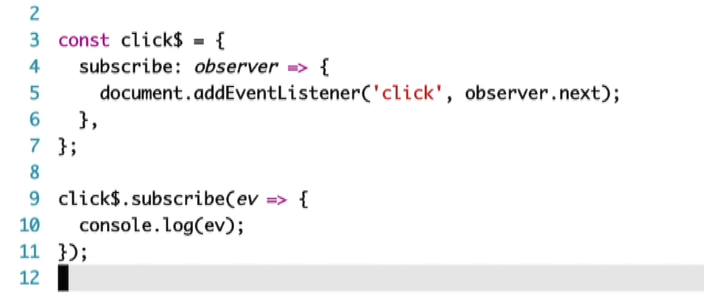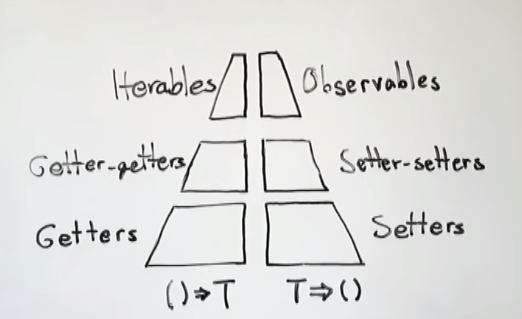[Javascript] Getter and Setter Abstractions
JavaScript provides primitive types and means of processing those. However, those are not enough. Real data must somehow come into the program and data must somehow leave the program, for it to become useful to us. In this talk, we will see how two abstractions are essential for data flow and to build up other abstractions, such as Iterator, Iterable, Observable, Scheduling, and others. Talk
Getter as abstractions:
const ten = ; // Abstractions
// Laziness
const getTen = () => { console.log("hi"); // hook for side effects // Implementation flexibility
return + ;
// return 2 * 5;
// return 10
}
Benefits:
- First of all: 'getTen' if you don't call the function, the calcuation inside the fucntion never run.
- You can do any side effects inside function.
- Implmentation flexibility, you can do different ways to aecieve the same effects.
Think about this code:
function add(getX, getY) {
const x = getX();
const y = getY();
return x + y;
}
'getX' and 'getY' are abstract. What we are doing now is adding two abstract number in concrete world. What if we add in abstract world?
function add(getX, getY) {
return () => { // put code into a get getter function
const x = getX();
const y = getY();
return x + y;
}
}
Now the function are complete lazy, lazyniess is a good thing, when you have some lzay you use getter can make things concrete.
function add(getX, getY) {
return () => {
const x = getX();
const y = getY();
return x + y;
}
}
const getTen = () => ;
const getY = Math.random;
const getSum = add(getTen, getY); // so far no calcuation happens
Lazy initialization and lazy iteration:
let i = ;
const array = [,,,];
function getArrayItem() {
// lazy iteration
return array[i++];
} console.log(getArrayItem());
console.log(getArrayItem());
console.log(getArrayItem());
console.log(getArrayItem());
console.log(getArrayItem()); // undefined
This is a concrete example, we call the fucntion mutiplue time and loop though the array.
And we also see that after call result as 'undefined', if we want to loop the array again from zero idnex, we have to do:
let i = ;
const array = [,,,];
function getArrayItem() {
// lazy iteration
return array[i++];
} console.log(getArrayItem());
console.log(getArrayItem());
console.log(getArrayItem());
console.log(getArrayItem()); i = ;
console.log(getArrayItem());
console.log(getArrayItem());
console.log(getArrayItem());
console.log(getArrayItem());
We call
i = ;
Of course this is not good at all, we leak the information.
The way to improve it is by using getter & lazyniess:
function getGetArrayItem() {
// lazy initialization
let i = ;
const array = [,,,];
return function() {
// lazy iteration
return array[i++];
}
}
let getArrayItem = getGetArrayItem();
console.log(getArrayItem());
console.log(getArrayItem());
console.log(getArrayItem());
console.log(getArrayItem());
getArrayItem = getGetArrayItem();
console.log(getArrayItem());
console.log(getArrayItem());
console.log(getArrayItem());
console.log(getArrayItem());
getter-getter: Abstract List:
Think about the following example:
function range(left, right) {
return () => {
// lazy initialization
let x = left;
return () => {
// lazy iteration
if (x > right) {
return undefined;
}
return x++;
}
}
}
const getGet = range( , );
const get = getGet();
console.log(get()); //
console.log(get());
console.log(get());
console.log(get());
console.log(get()); //
console.log(get()); // undefined
console.log(get());
console.log(get());
It prints out the range of nuber, which we defined, we can notice after the right limit of the number, it just print out undefined.
One way to solve the undefined problem is using for loop:
function range(left, right) {
return () => {
// lazy initialization
let x = left;
return () => {
// lazy iteration
if (x > right) {
return undefined;
}
return x++;
}
}
}
const getGet = range( , );
for(let get = getGet(), x = get(); x !== undefined; x = get()) {
console.log(x) // 10 ... 14
}
The good thing about this code is that no matter how large the range it is, the menory size is always 1. Every time you call the fucntion, it pull one value from the abstract getter function every time. It makes CPU and memory efficient.
Completion markers:
function range(left, right) {
return () => {
// lazy initialization
let x = left;
return () => {
// lazy iteration
if (x > right) {
return {done: true};
}
return {done: false, value: x++};
}
}
}
const getGet = range(, );
for(let get = getGet(), res = get(); !res.done; res = get()) {
console.log(res.value) // 10 ... 14
}
We added {done: true | false} as a complete marker.
Convert to Symbol.iterator:
function range(left, right) {
return {
[Symbol.iterator]: () => {
// lazy initialization
let x = left;
return {
next: () => {
// lazy iteration
if (x > right) {
return {done: true};
}
return {done: false, value: x++};
}
}
}
}
}
Javascript notice that when you are using [Symbol.iterator] and have 'next' inside, then it provides you a nice syntax to loop over the iterator and get the value of out it.
for(let x of range(, )) {
console.log(x) // 10 ... 14
}
We might have done this:
function range(left, right) {
return {
[Symbol.iterator]: () => {
// lazy initialization
let x = left;
return {
next: () => {
// lazy iteration
if (x > right) {
return {done: true};
}
return {done: false, value: x++};
}
}
}
}
}
for(let x of range(,)) {
if(x % === ) {
console.log(x)
}
}
We using 'if' inside 'for' loop, well it is nothing wrong, but we can do better. Because range() is abstract function, we don't need to pull all the value done to the concrete world to do the filtering, we can also do the filtering in abstract function.
const filter = pred => iterations => {
let z = [];
for (let x of iterations) {
if(pred(x)) z.push(x);
}
return z;
};
function range(left, right) {
return {
[Symbol.iterator]: () => {
// lazy initialization
let x = left;
return {
next: () => {
// lazy iteration
if (x > right) {
return {done: true};
}
return {done: false, value: x++};
}
}
}
}
}
for(let x of filter(x => x % === )(range(,))) {
console.log(x)
}
Setter-setter abstraction:
You can think of "setter-setter" is callback:
const setSetTen = (setTen) => {
setTen()
}
setSetTen(console.log) //
The benifits of doing setter-setter is
- Async
- Inversion of control
const setSetTen = (setTen) => {
setTimeout(() => {
//Async
setTen()
}, )
}
setSetTen(console.log) //
Setter-setter to Observable:


[Javascript] Getter and Setter Abstractions的更多相关文章
- JavaScript getter and setter All In One
JavaScript getter and setter All In One getter & setter JavaScript Object Accessors JavaScript A ...
- JavaScript getter和setter
对象的属性是由属性名name,值key,和其他特性(可读写性 writable,可枚举性enumerable,可配置性configurable)组成的.从ES5开发,提供了getter和setter ...
- javascript的getter和setter(转)
显然这是一个无关IE(高级IE除外)的话题,尽管如此,有兴趣的同学还是一起来认识一下ECMAScript5标准中getter和setter的实现.在一个对象中,操作其中的属性或方法,通常运用最多的就是 ...
- JavaScript中闭包实现的私有属性的getter()和setter()方法
注意: 以下的输出都在浏览器的控制台中 <!DOCTYPE html> <html> <head> <meta charset="utf-8&quo ...
- javascript中的function命名空間與模擬getter、setter
function的命名空間 在javascript中,function也可以擁有自己的命名空間例如以下這段程式碼: 12345678 function () { return 'I am A';} A ...
- javascript权威指南笔记--javascript语言核心(五)--getter和setter属性
getter和setter属性: var p = { x:1.0, y:1.0, get r(){ return Math.sqrt(this.x*this.x + this.y * this.y); ...
- javascript中的getter和setter
在ECMAScript 5中,属性值可以用一个或两个方法代替,这两个方法就是getter和setter var man = { name : 'lidg', weibo : '@lidg', get ...
- 基于 getter 和 setter 撸一个简易的MVVM
Angular 和 Vue 在对Angular的学习中,了解到AngularJS 的两个主要缺点: 对于每一次界面时间,Ajax 或者 timeout,都会进行一个脏检查,而每一次脏检查又会在内部循环 ...
- js中的访问器属性中的getter和setter函数实现数据双向绑定
嗯,之前在读js红宝书的时候,在对象那一章有介绍属性类型.第一种数据类型指的是数据属性,第二种是访问器属性.在初识vue的时候,其双向数据绑定也是基于访问器属性中的getter和setter函数原理来 ...
随机推荐
- Section %post does not end with %end
Section %post does not end with %end Exception AttributeError: "NoneType" object no attrib ...
- Gym - 101981A The 2018 ICPC Asia Nanjing Regional Contest A.Adrien and Austin 简单博弈
题面 题意:一堆有n个石子,编号从1⋯N排成一列,两个人Adrien 和Austin玩游戏,每次可以取1⋯K个连续编号的石子,Adrien先手,谁不能取了则输 题解:k==1时,显然和n奇偶相关,当k ...
- SfMLearner论文笔记——Unsupervised Learning of Depth and Ego-Motion from Video
1. Abstract 提出了一种无监督单目深度估计和相机运动估计的框架 利用视觉合成作为监督信息,使用端到端的方式学习 网络分为两部分(严格意义上是三个) 单目深度估计 多视图姿态估计 解释性网络( ...
- mybatis parameterType报错:There is no getter for property named 'xxx' in 'class java.lang.String'
方法1: 当parameterType = "java.lang.String" 的时候,参数读取的时候必须为 _parameter 方法2: 在dao层的时候,设置一下参数,此方 ...
- A - Supermarket
Problem description We often go to supermarkets to buy some fruits or vegetables, and on the tag the ...
- SQLServer2008 将“单个用户”改为“多用户”
一开始是要想要分离掉数据库,然后将其删除 不知道为什么一直分离不了,试了很多次,又尝试直接删除 结果数据库突然显示成了“单个用户” 尝试查看其属性,或者“新建查询”也都报错,提示已经有其他用户建立了连 ...
- JS 有趣的eval优化输入验证
//eval就是计算字符串[可以放任何js代码]里的值 . var str1='12+3'; eval(str1); . var str2='[1,2,3]'; eval(str2[]); .eval ...
- 元信息标记---meta
位于<head></head>之间 1.设置页面关键字: <meta name="keywords" content="输入具体关键字&qu ...
- 【Oracle】进入sqlplus 删除键backspace时出现^H
当oracle进入sqlplus后,输入命令时候出现错误,我们按平时的习惯使用backspace键删除错误信息,此时会出现^H 解决办法:进入sqlplus之前,使用stty erase '^H'命令 ...
- Verification之PSL之intro
1 PSL - Property specification language 1.1 Property - Characteristics of the designs/verification e ...
